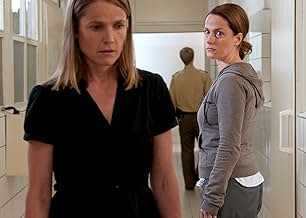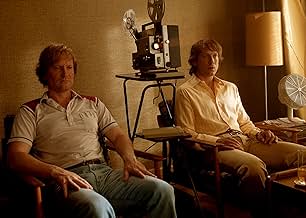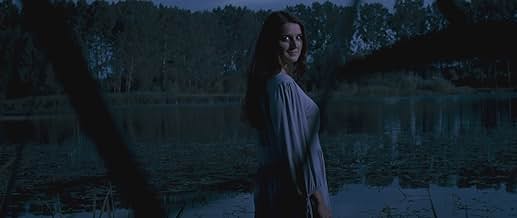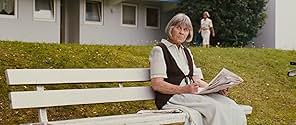PUNTUACIÓN EN IMDb
6,9/10
8,7 mil
TU PUNTUACIÓN
Sinikka, de 13 años, desaparece en una calurosa noche de verano. Su bicicleta se encuentra en el lugar exacto donde mataron a una niña hace 23 años. El presente dramático obliga a los involu... Leer todoSinikka, de 13 años, desaparece en una calurosa noche de verano. Su bicicleta se encuentra en el lugar exacto donde mataron a una niña hace 23 años. El presente dramático obliga a los involucrados en el caso original a enfrentar su pasado.Sinikka, de 13 años, desaparece en una calurosa noche de verano. Su bicicleta se encuentra en el lugar exacto donde mataron a una niña hace 23 años. El presente dramático obliga a los involucrados en el caso original a enfrentar su pasado.
- Dirección
- Guión
- Reparto principal
- Premios
- 1 premio y 4 nominaciones en total
Amon Wendel
- Malte
- (as Amon Robert Wendel)
Lena Klenke
- Sinikka
- (as Anna-Lena Klenke)
Helene Luise Doppler
- Pia
- (as Helene Doppler)
Reseñas destacadas
Baran bo Odar's film begins almost wordlessly on a sunny day in 1986. Two men driving along in a red car (Ulrich Thomsen, Wotan Wilke Möhring) encounter a young girl riding a bicycle (Helene Doppler). They pursue her into a cornfield where one of the men rapes her, kills her with a blow to the head and dumps her corpse in an adjacent lake.
Fast forward to 2009, and one of the two men (Möhring) has become a successful architect, married with two children, while the other (Thomsen) works full-time as a caretaker. The memory of that traumatic occasion haunts both of them, creating a complicated web of lies, deceit and implication that leads to the murder of another young girl (Anna-Lena Klenke).
The film's title not only refers to the silence practiced by the perpetrators of the original crime in 1986, but also describes other people's state of mind. For twenty-three years the murdered girl's mother (Katrin Sass) has kept silent about her harrowing ordeal; likewise the police inspector (Burghart Klaussner) who was involved in the original investigation but failed to achieve a result. It is only after this lengthy time-lapse that they decide to come out and voice their feelings, as well as trying to reconcile themselves to what happened in the past.
Shot in garishly bright colors (by Nikolaus Summerer) creating a world of apparently endless summer weather that nonetheless appears highly dystopian, THE SILENCE offers an insight into the pedophile mind, which often thinks it is doing nothing wrong, even while taking a perverted pleasure in watching child porn videos. The film also takes a look at the ways in which such people are allowed to flourish in societies that prefer to turn their collective backs on such unpleasant issues in the belief that everyone is fundamentally well-intentioned. bo Odar's film proves precisely the opposite; it is often the outwardly most respectable people that prove the most dangerous.
Fast forward to 2009, and one of the two men (Möhring) has become a successful architect, married with two children, while the other (Thomsen) works full-time as a caretaker. The memory of that traumatic occasion haunts both of them, creating a complicated web of lies, deceit and implication that leads to the murder of another young girl (Anna-Lena Klenke).
The film's title not only refers to the silence practiced by the perpetrators of the original crime in 1986, but also describes other people's state of mind. For twenty-three years the murdered girl's mother (Katrin Sass) has kept silent about her harrowing ordeal; likewise the police inspector (Burghart Klaussner) who was involved in the original investigation but failed to achieve a result. It is only after this lengthy time-lapse that they decide to come out and voice their feelings, as well as trying to reconcile themselves to what happened in the past.
Shot in garishly bright colors (by Nikolaus Summerer) creating a world of apparently endless summer weather that nonetheless appears highly dystopian, THE SILENCE offers an insight into the pedophile mind, which often thinks it is doing nothing wrong, even while taking a perverted pleasure in watching child porn videos. The film also takes a look at the ways in which such people are allowed to flourish in societies that prefer to turn their collective backs on such unpleasant issues in the belief that everyone is fundamentally well-intentioned. bo Odar's film proves precisely the opposite; it is often the outwardly most respectable people that prove the most dangerous.
"Das Letzte Schweigen" a.k.a. "The Silence" is a sleeper thriller that genuinely shocked and dumbfounded me, but mainly AFTER it was finished! It's the type of film that slowly gets under your skin and the true horror of the plot only hits you afterwards, because you are subconsciously analyzing and re-processing the agitating events over and over again. It was quite a harsh confrontation for me, especially because I'm into dark and devastating horror & cult cinema for nearly two decades now and I have seen numerous of allegedly controversial movies. But "The Silence" is largely different to anything I have ever seen before. It's an extremely slow and moody tale full of totally messed up characters (not a single one qualifies as even remotely normal) and horrifying events & themes that are depicted in a nihilistic and almost everyday fashion. The plot gradually unfolds and the viewer absorbs everything that is coming at him/her, but the truly evil nature of the denouement and the injustice of the climax only hit you – and quite hard, I may add - once the end credits are rolling over the screen. The story starts in a remote little German town in the summer of 1986. Two young men, who share the disgusting passion of watching child pornography (it's not explicitly shown but clearly suggested), are driving around in their red Volkswagen when they spot an 11-year-old girl bike-riding on a dirt road. One of them, Peer Sommer, viciously rapes and murders the defenselessly screaming girl while his pal Timo remains motionless and petrified in the car. Shortly after the incident, Timo flees away from Peer in an attempt to forget everything that has happened and start a new life elsewhere. 23 years later, on the exact same day and on the exact same place, the bicycle and a couple of blood stains of 13-year-old Sinikka Weghamm are discovered. The disappearance of the girl is a nightmare for her parents, but also for the mother of the still unsolved previous murder case as well as for the police officers – retired and incompetent new ones – that are charged with the case. Is it the work of a copycat killer or has the original killer returned? The truth is even more nightmarish than anything you can think of. "The Silence" benefices from a continuously foreboding atmosphere and the gradually revealed details of the case make you uncomfortable. At several points during the movie, you'll find yourself cursing and screaming at the screen in an attempt to speed up the slow police investigation. Themes like child murder and pedophilia automatically make any thriller disturbing, but the sober tone and bleak characters in "The Silence" are almost unbearable. Young director Baran Bo Odar maintains the nail-biting ambiance throughout the entire film and all the acting performances, particularly those of Ulrich Thomsen and Wotan Wilke Möhring, are deeply impressive. There are definitely some plot holes to detect regarding the police investigation and the involvement of the media, but somehow it feels like a factual murder case really could be as ineptly led as this one. The total absence of music, humor and certain background explanations only make the film more haunting. This definitely isn't viewing material for everyone, but highly recommended to thriller fanatics in search of a mature and complex story.
Suspense fans tired of low-brow, explicit exploitation movies may want to check out "The Silence," an absorbing German thriller that delivers the suspense without sacrificing the drama. At a confident and steady pace, the script allows the characters to develop powerful, yet subtle performances.
On July 8th, 1986, a eleven year old girl Pia (Helene Doppler) is raped and murdered by Peer (Ulrich Thomsen) while a second man, Timo (Wotan Wilke Möhring), watches with equal parts of disgust and arousal. The two dispose of the body and return home, but while Peer began to destroy any potential evidence, Timo has already packed and boarded a bus out of town. 23 years later, to the very day, another young girl goes missing with only her bike and bag left behind at the very spot where Pia was abducted years ago. Writer/director Baran bo Odar's film, "The Silence," follows the distraught families, the police, and the two men behind the original unsolved case in a story that explores grief and guilt, obsession and duty.
It's a well-acted, emotion-charged drama whose murder mystery is almost secondary to the human element. It's a complex examination of the many facets of humanity in which even those who commit the most heinous acts aren't complete monsters. The film is about tragedy and the everlasting impact on those involved, from the victims to the perpetrators.
Director Baran bo Odar maintains a sense of morbid fascination in a film that in someone else's hands might become overwhelmingly unpleasant. Despite its nearly two-hour running time, it never becomes dull or depressing, thanks in part to large cast of characters whose nuanced portrayals strike a chord of truth -- terrifyingly so for any parent. Even though the conclusion isn't exactly overpowering, the journey is remarkably nuanced and compelling – and most certainly an uncomfortable one.
On July 8th, 1986, a eleven year old girl Pia (Helene Doppler) is raped and murdered by Peer (Ulrich Thomsen) while a second man, Timo (Wotan Wilke Möhring), watches with equal parts of disgust and arousal. The two dispose of the body and return home, but while Peer began to destroy any potential evidence, Timo has already packed and boarded a bus out of town. 23 years later, to the very day, another young girl goes missing with only her bike and bag left behind at the very spot where Pia was abducted years ago. Writer/director Baran bo Odar's film, "The Silence," follows the distraught families, the police, and the two men behind the original unsolved case in a story that explores grief and guilt, obsession and duty.
It's a well-acted, emotion-charged drama whose murder mystery is almost secondary to the human element. It's a complex examination of the many facets of humanity in which even those who commit the most heinous acts aren't complete monsters. The film is about tragedy and the everlasting impact on those involved, from the victims to the perpetrators.
Director Baran bo Odar maintains a sense of morbid fascination in a film that in someone else's hands might become overwhelmingly unpleasant. Despite its nearly two-hour running time, it never becomes dull or depressing, thanks in part to large cast of characters whose nuanced portrayals strike a chord of truth -- terrifyingly so for any parent. Even though the conclusion isn't exactly overpowering, the journey is remarkably nuanced and compelling – and most certainly an uncomfortable one.
THE SILENCE is a German murder mystery that's heavily indebted to two separate sources: firstly, the whole look and mood of the currently-popular Scandinavian cop shows (such as THE KILLING), from which the style of music is frequently ripped off (like that whole thing with a single, deep note held for a while). Meanwhile, the plot and police investigation bear more than a hint of the exceptional South Korean drama, MEMORIES OF MURDER.
What follows is predictable but occasionally highly gripping, and strangely enough different sub-plots in the movie have different levels of interest. I admit that I found the whole police investigation to be pretty dull; there isn't actually much investigating taking place, and it all seems very slow and stately. The scenes of grieving parents are so familiar by now that they didn't affect me at all.
A second, alternate part of the film follows the friendship between two men, one of whom is a paedophile and murderer. This part of the film is exceptionally, dealing with dodgy subject matter in an intensely gripping way. Ulrich Thomsen (from THE THING remake) and Wotan Wilke Mohring are both very good here, and I would have much preferred the whole film to concentrate on these two by doing away with the predictable police stuff altogether. However, what we're left with is a real film of two halves; one's powerful stuff indeed, and the other's best forgotten.
What follows is predictable but occasionally highly gripping, and strangely enough different sub-plots in the movie have different levels of interest. I admit that I found the whole police investigation to be pretty dull; there isn't actually much investigating taking place, and it all seems very slow and stately. The scenes of grieving parents are so familiar by now that they didn't affect me at all.
A second, alternate part of the film follows the friendship between two men, one of whom is a paedophile and murderer. This part of the film is exceptionally, dealing with dodgy subject matter in an intensely gripping way. Ulrich Thomsen (from THE THING remake) and Wotan Wilke Mohring are both very good here, and I would have much preferred the whole film to concentrate on these two by doing away with the predictable police stuff altogether. However, what we're left with is a real film of two halves; one's powerful stuff indeed, and the other's best forgotten.
In 1986, an 11 year old girl Pia is raped and murdered in a wheat field near a small German town by one man while another watched. Her bicycle was left in the field and the killer was never found. The man who watched takes off after the murder. Twenty three years later, 13 year old Sinikka Weghamm goes missing after the local fair. Her bicycle is found at the site of Pia murder.
This is another dark psychological crime thriller. It is a good representation of the ugliness amidst the normal everyday society. The dark subject matter is normal for these types of movies nowadays. It would be shocking 20 years ago. Today, it's on network TV. The actors do a fine depicting these characters under stress. It remains intriguing until the end.
This is another dark psychological crime thriller. It is a good representation of the ugliness amidst the normal everyday society. The dark subject matter is normal for these types of movies nowadays. It would be shocking 20 years ago. Today, it's on network TV. The actors do a fine depicting these characters under stress. It remains intriguing until the end.
¿Sabías que...?
- CuriosidadesDirector Baran bo Odar has said that South Korean movie Memories of Murder (Crónica de un asesino en serie) (2003) was a big inspiration for this movie.
- PifiasAt the start of the TV interview the clock in the control room counts up to 21:40:11 until a cut. Several short scenes later the same clock is shown, again counting up to 21:40:11.
- Banda sonoraPia
written & produced by Michael Kamm, Kris Steininger (as Pas de Deux)
Selecciones populares
Inicia sesión para calificar y añadir a tu lista para recibir recomendaciones personalizadas
- How long is The Silence?Con tecnología de Alexa
Detalles
Taquilla
- Presupuesto
- 2.300.000 € (estimación)
- Recaudación en Estados Unidos y Canadá
- 100.214 US$
- Fin de semana de estreno en EE. UU. y Canadá
- 7992 US$
- 10 mar 2013
- Recaudación en todo el mundo
- 416.675 US$
- Duración
- 1h 58min(118 min)
- Color
- Mezcla de sonido
- Relación de aspecto
- 2.35 : 1
Contribuir a esta página
Sugerir un cambio o añadir el contenido que falta































